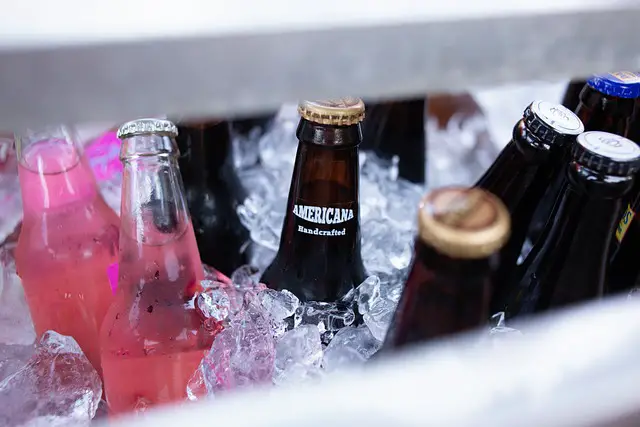This post contains affiliate links.
Buying a cool box is a personal choice and often depends on the available budget and safety aspects. Although we often think the more expensive is best, your camping style and pitch set-up must be considered.
How do you decide on the type of cool box, and what is the difference?
Passive cool boxes are for camping with no EHU, picnics and ice-pack to keep food cool, available as bags or rigid boxes. Thermoelectrics are 12V car or 240V mains connections extracting warm air via a fan. The most commonly used coolbox for family camping Absorption is multi-fueled, electric or gas-powered but requires full ventilation for safety. Compressor cool boxes are similar to a fridge and only require 3 Amps per day—ideal for off-grid camping motor homes. Absorption and compressor are thermostatic control and will hold the temperatures set.
Deciding on a cool box can be confusing as many different types exist. Ranging from budget cool boxes to the more extreme camping cool boxes. Understanding the difference will save you money and help avoid disappointment as you have purchased a cooler that is not suitable.
What type of cool box do you need for camping?
Choosing the right coolbox for your camping adventures depends on the nature of your holiday. Whether camping on a fully equipped campsite with electrical hook-ups (EHU) or opting for a more semi-wild camping experience, the type of cool box you select can make a significant difference.
Cool boxes – What type do you need for your trip?
| Type of cool box | Type of camping trip and why the cool box is suitable |
|---|---|
| Passive Cool Box | Type of trip – Campsite, semi-wild camping, car camping Why – It does not need an EHU connection making it portable. Ideal for picnics or days out. However, you will need ice blocks or ice to help maintain coolness inside for camping. Variety of styles available – rigid, soft or inflatable. |
| Thermoelectric Cool Box | Type of trip – Onsite, where you have access to EHU Why – Most common cool box used by families. Needs continuous EHU connection. Not very energy efficient, and it is not advised to leave it connected to an in-car charge or leisure battery. |
| Compressor Cool Box | Type of trip – Onside campsite, motorhomes, caravans Why – Needs EHU 240V or 12V connection. It can be charged in a car or leisure battery. Heavy and bulky to transport and similar to a fridge in a home. |
| Absorption Cool Box | Type of trip – Off-grid, campsites, motorhomes, campervans Why – Powered by gas or electricity. Although gas-powered needs full ventilation due to fumes. Very bulky and heavy and need to be in a fixed location. |
Choosing a cool box for camping: What type of camping trip?
What you need to consider before buying a cool box
| Ask yourself | What to consider before buying a cool box |
|---|---|
| Budget | Knowing how much you can spend on a cool box will help determine the type and size. |
| EHU Connection | This is combined with your holiday length and the number of people in your camping group. The number of people and the length of the holiday will determine the cool box capacity. |
| How often do you camp? | If you camp regularly, invest in a good quality cool box that lasts several years. |
| Weather conditions | The season you camp and the outside temperature will determine the quality of a cool box. A cheaper, less insulated coolbox will require continuous freeze blocks or ice bag rotation for high outside temperatures. |
| Number of people in your group | This is combined with how long your holiday is and the number of people in your camping group. The number of people and the length of the holiday will determine the cool box capacity. |
| How long is your holiday? | Camping for a couple of nights, you only need a small coolbox. You will need sufficient space to store food for a few nights and drinks that must be kept cool. |
| Transportation | Is there a space limit in your vehicle? This will determine if a rigid or soft case cool box is suitable. If you use public transport to travel to your campsite, a soft casing or an inflatable coolbox will be more suitable. |
| Access to local stores | If you have access to food stores, you do not need to take as much food as you can buy whilst you are away. Many campsites will have small stores selling the main essentials and often provide BBQ packages for additional fees. |
| Storage after your camping trip | Consider where you will store your cool box after your trip. |
| Access to campsite freezers | 90% of campsites offer a free freezer facility. You can rotate freeze blocks to keep your food cool or use their freezer to store frozen food. |
What are the different types of cool boxes?
- Thermoelectrical coolbox (Electrical) – Runs on Mains power and 12V
- Passive Coolbox – Kept cool with ice blocks
- Compressor Coolbox – 240v & 12V – similar to mini fridge
- Absorption Coolbox – Gas-powered needs ventilation
Understanding thermoelectric coolboxes for camping
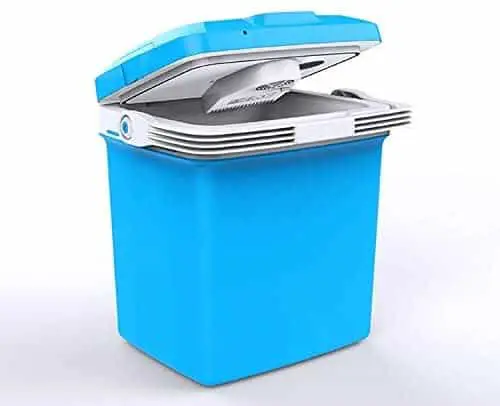
Thermoelectrical coolbox
- Expect to pay – £32 – £169
- Capacity range – 7.5L – 48L
- It runs on 240V and car 12V connection
- It can have two settings – warm and cool
- The fan extracts warm air from the inside.
- Constant noise but becomes background noise
- Reasonably priced cool box
- Ideal for family camping holidays
When choosing a coolbox for your camping trip, it is important to understand the different types of cool boxes. Specifically, thermoelectric models like the Leisure Direct 32L are essential for successful family camping. Consider factors such as power options, noise levels, cooling techniques, and usage duration to make an informed choice.
Thermoelectric cool boxes are the most common family camping cool box due to the ease of use and cost compared to absorption and compressor cool boxes.
- Thermoelectric coolboxes – Efficient and affordable thermoelectric coolboxes are the most popular choice for family camping due to their ease of use and cost-effectiveness compared to absorption and compressor cool boxes. They operate using a fan system in the lid, which draws out warm air. Although the constant fan rotation creates a buzzing sound, it becomes background noise over time. Manufacturers have developed double fan models to reduce noise levels, a feature likely to become standard.
- Power options and usage duration: Thermoelectric cool boxes typically run on a 240V connection and a 12V car charger. While the in-car charger allows you to keep the cool box running during travel, it’s essential to have a constant electrical supply when on site. Note that these coolers are suitable for an electric hookup (EHU) connection, as they are not energy-efficient and can quickly drain a leisure battery. On average, they consume around 4 Amps per day.
- Cooling and preparing for use: Before utilizing a thermoelectric coolbox, it must be cooled in advance. Starting the cooling process the night before and placing pre-cooled food inside on the day of travel is recommended. While additional freeze blocks or ice are unnecessary, they can help maintain the temperature in high ambient outside conditions.
- Choosing the right coolbox – Selecting the most suitable cool box depends on the duration of your camping trip, the number of people in your group, and the type of food you plan to bring. We tested five electrical coolboxes for various camping scenarios, including long-haul trips and short weekend breaks, to determine their suitability. Assess your specific needs to find the perfect coolbox for your camping adventures.
Did you know that air gaps in your cool box can decrease the cooling duration of your food? Discover effective packing techniques and utilize food items strategically to maintain optimal coolness. Learn about selecting suitable types of food to minimize wastage and maximize cooling efficiency during your camping trips.
Discover the top budget-friendly electrical coolboxes that provide excellent cooling performance without breaking the bank! Explore our selection of the best budget electrical coolboxes, perfect for refreshingly chilling your food and drinks during your camping adventures. Don’t compromise on quality or affordability.
Understanding passive coolboxes for camping
Passive cool box
- Expect to pay – £69 – £82
- It can be rigid, soft, or inflatable
- Need to be cooled before placing food inside
- Place precooled food only
- It will need ice blocks or ice to keep cool
- Outside temperatures will determine the length of time your food will remain cool.
- Waterproof
- The majority will have a water drain tap
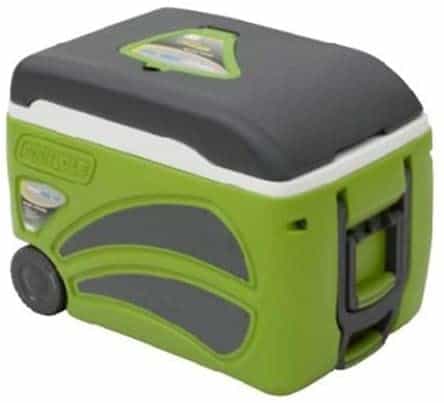
Passive cool boxes offer practicality, affordability, and temperature control for camping adventures. By understanding their capacity, insulation quality, and compliance with regulations, you can make informed choices for your camping needs.
- Capacity and usage considerations – Passive coolboxes come in different sizes, depending on your chosen type. Rigid coolboxes for camping typically range from 20L to 66L, while soft cool bags, suitable for picnic lunches, range from 7.5L to 32L. For camping purposes, a larger collapsible cool bag with a capacity of around 20L is recommended, providing ample space for food and drinks for a few days. However, be mindful of the weight limit and the durability of handles when packing heavy items.
- Cooling duration and temperature control – The cooling duration of passive cool boxes can vary, reaching a maximum of 100 hours when combined with ice blocks or ice. However, the quality of insulation plays a crucial role in maintaining cooling efficiency. Cheaper cool boxes may have inadequate insulation compared to more expensive models. The internal temperature of the cool box is also influenced by ambient outside temperatures and how frequently the box is opened. Consider using separate cool boxes for everyday drinks and perishable items that require constant cold temperatures.
- Comparison with electrical coolboxes – A passive cool box can be a cost-effective alternative if your campsite provides freezer facilities. While a 66L passive cool box costs a maximum of £139.99, a standard 32L thermoelectric rigid cool box averages £69.99 – £79.99. However, it’s essential to understand the pros and cons of each type and evaluate your specific camping needs before making a decision.
- Compliance and testing – Passive cool boxes must comply with EN 12546-2 regulations to meet insulation and food contact requirements. We have tested six passive cool boxes that adhere to these regulations, assessing factors such as ease of transport, handling, and cooling duration. Our comprehensive analysis aims to assist you in choosing the correct passive cool box for your camping adventures.
Looking to keep your food cool and fresh during your camping trips without relying on electricity? Discover the best budget-friendly passive coolboxes and learn 14 essential tips on effectively packing and maintaining your passive coolbox’s coldness. Don’t let your food spoil or compromise on convenience.
Understanding Compressor Coolboxes for Camping
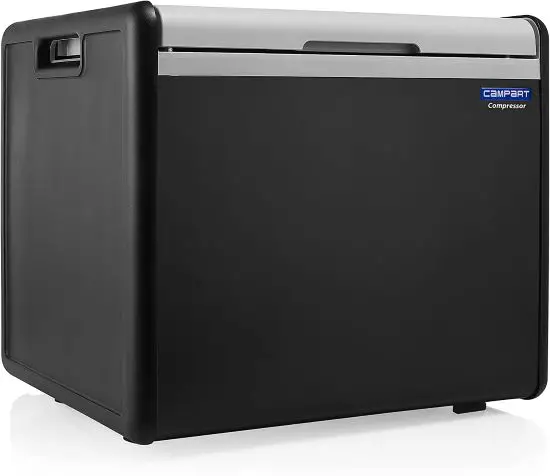
Compressor cool box
- Expect to Pay – £235 – £499
- Capacity – 15L – 60L
- Runs on 240V and car 12V connection
- Dual – Fridge and freezer
- It turns off when it reaches the required temperatures
- It can be noisy – like a fridge at home
- Very bulky
- Cheap to run – only 0.2 – 0.3 Amps per hour
Compressor coolboxes are the ideal cooling solution for campers seeking precise temperature control and reliability. They are energy efficient, suitable for off-grid camping and valuable asset for camping in high-temperature. Compared to absorption coolboxes, they are cheaper at a maximum cost of £499, but not ideal if you want to keep costs to a minimum.
- Functionality and power options – Compressor coolboxes operate similarly to everyday home fridges, making them differ from popular thermoelectric cool boxes. They are powered by electricity through a car’s 12V charge or a mains 240V connection. While not recommended for budget-conscious campers due to their higher cost and bulkiness than other coolbox types. Compressor coolboxes maintain specific temperatures, making them ideal for storing medications that require precise temperature control.
- Noise level and energy efficiency – Compressor models are remarkably quiet compared to thermoelectric coolboxes. The only noticeable noise will be the occasional clicking on and off. As well as a gentle humming sound during the cooling process—similar to the background noise of your home fridge. Energy-wise, compressor cool boxes are highly efficient, consuming only 0.2 – 0.3 Amps per hour. This makes them an excellent choice for off-grid camping or motorhome trips, where a 100 Amp leisure battery can last up to 333 hours based on a consumption rate of 0.3 Amp.
- Design and compartmentalization – Compressor coolboxes feature a bulky design similar to mini chest freezers. Depending on the model chosen, they may have separate compartments, including standard fridge and freezer sections. This compartmentalization allows for organized storage and ensures your food and beverages stay at the desired temperature for longer. While their larger size may require extra consideration for transportation and storage, the benefits in terms of cooling performance outweigh the space requirements for many campers.
- Suitability for high-tTemperature camping – Investing in a compressor coolbox is a wise choice if you frequently camp in high-temperature environments. It’s superior cooling capabilities and temperature maintenance make it an ideal solution for keeping your food and beverages safe and enjoyable, even in extreme heat conditions. Whether camping in hot climates or embarking on summer adventures, a compressor coolbox will ensure your perishable items stay fresh and cool throughout your trip.
Absorption coolboxes: The ultimate cooling solution for Family camping
Absorption cool box
- Expect to pay – £279 – £699
- Capacity – 41L – 50L
- Powered 3 ways – Gas, 12v and 240v
- Temperature controlled
- Gas powered not suitable for everyday family camping
- 6kg gas can last up to 24 days
- Needs to settle for 24 hrs before using
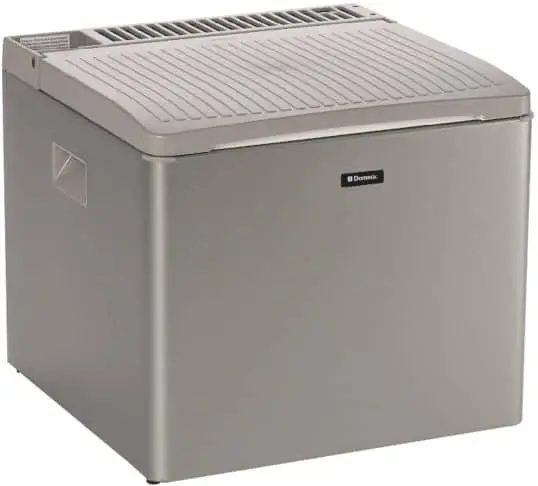
Absorption cool boxes are the perfect cooling solution for family camping, semi-wild explorations, and off-grid adventures. They have thermostatic control for precise temperature regulation, fuel options and are ideal for specific camping scenarios. However, they are one of the most expensive coolboxes you can buy, on average £699.
- Three-way fuel options – Absorption cool boxes are three-way fueled cool boxes, offering flexibility in power sources. You can operate them using a 12V car connection, a 240V mains connection, or gas power. However, it’s important to note that they are less economical than other coolbox types, consuming approximately 200 – 250g of gas daily. With a 6kg gas container, you can expect it to last around 24 days on average. This fuel versatility makes absorption cool boxes ideal for off-grid camping scenarios where electricity is not readily available.
- Thermostatic control and temperature regulation – One of the standout features of absorption cool boxes is their thermostatic control. This feature allows you to adjust and maintain the internal temperature to suit your specific needs. With the ability to cut on/off when the desired temperatures are reached, you can ensure your food and beverages stay perfectly chilled throughout your camping trip. The thermostatic control feature enhances convenience and helps preserve the freshness of your perishable items.
- Considerations for tent camping and ventilation – When it comes to tent camping, it is essential to consider the ventilation requirements of absorption cool boxes. As they are gas-powered, proper ventilation is crucial to ensure the safe dispersion of carbon monoxide fumes. Compressors, which are excellent cool boxes, cannot be kept inside the main body of the tent due to these fumes. Instead, you will need an additional area with adequate ventilation and protection from the elements. For tent camping, opting for an electrical-powered cool box, either thermoelectric or absorption, is recommended to ensure a safe and comfortable camping experience.
- Comparing absorption vs thermostatic coolbox – While compressor coolboxes offer excellent cooling performance, absorption coolboxes are more suitable for specific camping scenarios. They excel in family camping and off-grid adventures, thanks to their thermostatic control and versatility in fuel options. Their resemblance to home fridges and the need for a flat surface during operation should be considered when choosing the correct coolbox for your camping needs. Assess your requirements, consider the available power sources, and make an informed decision based on the specific features and benefits of absorption cool boxes.
Related questions
How to choose what size of cool box you need?
Your cool box’s size depends on how long your holiday will be and the number of people in your group.
| Cool Box Size | How many litre bottles can be inside a cool box together |
|---|---|
| 24L | 4 x 1.5-litre bottles – 2 people |
| 25L | 12 x 0.75-litre bottles but not standing up – 2 people |
| 32L | 8 x 1.5-litre bottles – 2-3 people |
| 40L | 16 x 0.75-litre bottles standing up – 3-4 people |
| 55L | 22 x 0.75- litre bottles standing up – larger groups |
Are cool boxes worth buying for camping?
Investing in a cool box is a game-changer when it comes to camping in warmer temperatures. Whether you opt for a passive cool box or a thermoelectric one, these portable refrigeration units play a vital role in keeping your food and drink cool and fresh. However, it’s essential to use them correctly to maximize their effectiveness.
To ensure optimal performance, remember to:
- Avoid leaving your cool box in direct sunlight.
- Remember that the inside of a tent can get hotter than the outside temperature.
- Pack your cool box tightly without leaving empty spaces, which helps maintain coolness.
- Minimize opening and closing the cool box frequently to prevent temperature fluctuations.
While it is possible to camp without a cool box in cooler temperatures for a short duration, using a cool box offers more than just temperature control. It protects against pesky bugs and insects, ensuring your food remains secure and hygienic.
Furthermore, cool boxes are not limited to camping alone. They are versatile companions for picnics and backyard gatherings, keeping your food and beverages chilled and ready to be enjoyed.

